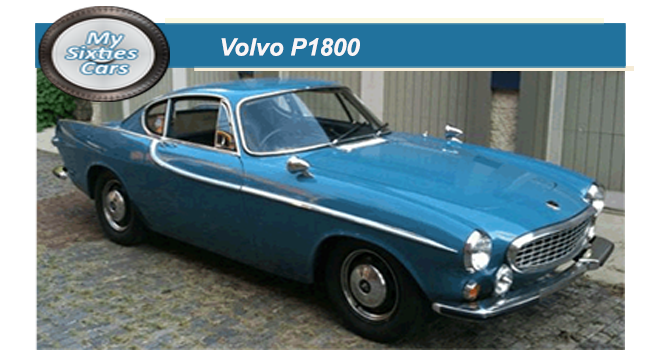
Despite the critical commercial failure of their first sports coupe, the P1900, launched in 1953 to a universal lack of interest, Volvo decided not to throw in the towel.
Learning from their mistakes with the P1900, Volvo brought in the father and son team of Helmer and Pelle Pettersen to create a coupe for the Sixties, displaying some humility be naming their coupe for the Sixties the P1800.
Well known in t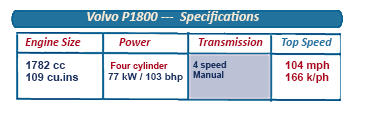 he field of racing yacht design, the Pettersen's dovetailed each other perfectly, Helmer handling the engineering aspects of the project while Pelle was responsible for the P1800’s design, although they did take advantage of some limited input from the renowned Italian design studio Frua.
he field of racing yacht design, the Pettersen's dovetailed each other perfectly, Helmer handling the engineering aspects of the project while Pelle was responsible for the P1800’s design, although they did take advantage of some limited input from the renowned Italian design studio Frua.
Preliminary wor
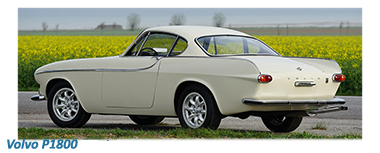 k on the P1800 design project got underway in the late Fifties, and , after much preparation and sould searching, the model was finally ready to make its public debut in 1961 at the Geneva Motor Show.
k on the P1800 design project got underway in the late Fifties, and , after much preparation and sould searching, the model was finally ready to make its public debut in 1961 at the Geneva Motor Show.
In retrospect, Volvo’s choice of timing could have been better because it was on that same stage that Jaguar unveiled their E-Type for the first time.
![]()
The P1800s line was much more restrained than the E-Type, it was decidedly less powerful, fitted with the same 1782cc engine than the Volvo 144 series, and was restricted to coupe format only.
The engine was 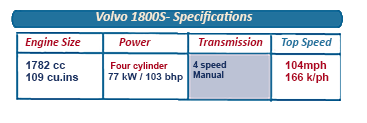 a specially engineered version of Volvo's reliable B18 plant with dual SU carburettors that gave outstanding performance with brisk acceleration via a manual four-speed gearbox.
a specially engineered version of Volvo's reliable B18 plant with dual SU carburettors that gave outstanding performance with brisk acceleration via a manual four-speed gearbox.
Overdrive, available as an optional extra, added even more oomph to the P1800
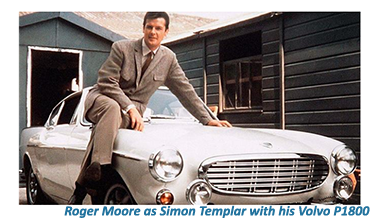 Despite having to emerge from the shadow of the E-type, the Volvo P1800 gained positive feedback from the motoring media, with sales beginning to mount up at a steady pace, not as much as the super Jaguar but certainly more than the 1900s.
Despite having to emerge from the shadow of the E-type, the Volvo P1800 gained positive feedback from the motoring media, with sales beginning to mount up at a steady pace, not as much as the super Jaguar but certainly more than the 1900s.
Volvo P1800’s marketing breakthrough came when the car was selected by a UK television actor and producer of the Sixties, for the TV series that he was due to beginning shooting in 1962, based on the adventures of private detective Simon Templar known as “ the Saint.”
![]()
Moore, who not only produced the series but played the lead role felt that the Volvo 1900 was the type of car that Templer, the typical English” man about town” of the Sixties would have chosen to drive- a blend of solidity, reliability and restrained power.
“The Saint” appeared on British television for seven seasons as well as being broadcast throughout the World, providing Volvo with tremendous coverage, which undoubtedly boosted sales considerably.
Possibly taken
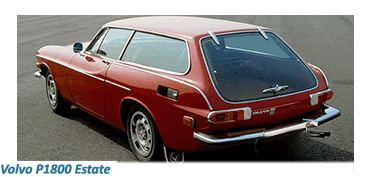 aback by its success, Volvo farmed out final assembly of the P1900 to Jensen, based in West Bromwich, in the Midlands of England using a body shell produced by the Rootes Group in the Hillman plant in Linwood, Scotland.
aback by its success, Volvo farmed out final assembly of the P1900 to Jensen, based in West Bromwich, in the Midlands of England using a body shell produced by the Rootes Group in the Hillman plant in Linwood, Scotland.
Such an arrangement could only mean logistics headaches, and after two years, production was moved exclusively to Sweden, with a resultant waiting list.
The Volvo P1900 remained in production till the early Seventies, clocking up around fifty-five thousand in sales, including eight thousand 1900ES, a strikingly attractive hatchback version.






